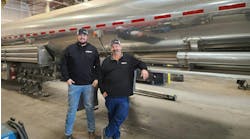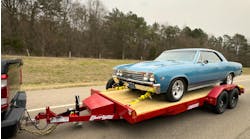Trailering trends: From electric vehicles and components, to cameras and trailer dollies, the future of the industry is here
Colin Holthaus, the technical director for the National Association of Trailer Manufacturers, provided an overview of current trends in trailering, including the rise of electric vehicles, cameras and trailer dollies, during the association’s annual convention. As always, trailer safety was a key topic.
Holthaus opened with 2017 statistics from the US Department of Transportation showing 13% of roadway fatalities involved commercial vehicles, primarily Class 8 trucks, and 82% of fatality victims in those incidents weren’t in a large truck, indicating they likely were in an involved passenger vehicle.
Also, DOT reported 6,000 pedestrian fatalities in 2017, which is 16% of all motor vehicle fatalities, an indication of the growing problem of distracted driving, which now is more deadly than drunk driving.
In other words, trailer safety, and roadway safety in general, is as important as ever.
Viewing the future
Along those lines, many of today’s trailering trends are safety-focused, including camera systems and advanced driver technology features, like trailer sway control and ABS brakes on trailers.
Cameras are growing in popularity for business and recreational trailer applications, from monitoring the back of a trailer and what’s around it, to keeping an eye on the contents inside the trailer.
The number of aftermarket cameras and monitoring systems is matching that growth, and Holthaus sees more integration coming, making camera connectivity an increasingly important feature.
Holthaus also said its important to educate customers on camera placement, and making sure they aren’t blocking the trailer’s reflectivity or lighting required by Federal Motor Vehicle Safety Standards.
Many OEMs now offer “transparent” trailer technology, which turns a towed trailer into a see-through silhouette.
General Motors and Ford sell their own cameras and systems for trailers.
The GM system on the 2020 Sierra Heavy Duty also features a new connection point and standardized connectors for attaching multiple systems, including cameras inside and outside the trailer.
“All these advancements on the automotive side really are making trailering safer,” Holthaus said.
Holthaus is looking for advancement in trailer sway and ABS systems, too. With the ever-increasing capabilities of new vehicles, trailer stability control systems are growing in importance, he said.
“ABS and cameras commonly have been thought of as a good thing to do on cars for so long there are legal requirements now, and the same good reasons are there for putting them on trailers,” Holthaus said.
Electrified vehicles
Electric vehicles are on the rise, too, which impacts the trailering world in terms of new tech and EV towing capabilities.
According to a recent Detroit Chambers report, 50-plus electric models currently are available in the United States, and auto manufacturers plan to introduce 56 more by 2022.
Of course, electric vehicles’ success is predicated on being able to charge them, adequately and conveniently.
Holthaus said the average energy usage for a 25-mile roundtrip commute is 6-8 kilowatts, which requires a recharge of 2-2.5 hours, and if there were 2.9 million electric vehicles on the road, the United States would require an additional 11,000 gigawatts of energy from its power grid.
“It’s got to come from somewhere,” he said. “It’s a definite challenge.
EVs tie into trailering, Holthaus said, because many manufacturers are debuting or planning to debut all-electric trucks, including the 2020 Rivian from Rivian Automotive, which Amazon and, most recently, Ford invested in heavily, which reportedly boasts an 11,000-pound towing capacity.
Atlas, another startup, says its all-electric truck will tow 17,000 pounds.
“It’s here, and it will be coming on a larger scale, slowly but surely,” Holthaus said.
GM, ASA command attention
Sticking with new trucks, GM, in association with ASA Electronics, recently developed a smart trailer integration system that works with ASA’s iN∙Command Control Systems, offering a new way for 2020 Silverado HD customers to bring RV controls and monitoring to the driver’s seat.
“This will allow for a number of firsts,” Holthaus said.
“Either on the end-user’s cell phone or on the monitor in the truck dash, it will allow users to do things for the first time like start the generator and start the air conditioner, while they’re inside the truck, or check the tire pressure on the trailer tires from the in-dash truck monitor, rather than having an extra system they’re looking at on their cell phone, and … that’s just the tip of the iceberg.”
Holthaus said the system also could allow for checking an RV’s gray water tank while going down the road.
GM, and other OEMs, also boasts a trailering app that allows users to go through a pre-departure check list, including a trailer light test and customizable trailer profiles for towing multiple trailers.
Trailer dollies
Another hot topic in recent NATM technical committee discussions is the trailer dolly.
Holthaus referred to a dolly he found online.
“This one runs on a rechargeable lithium ion battery, it’s got a 30-minute run time, it’s self-motorized and remote-controlled, but the operator’s got to be within 40 feet to operate it,” Holthaus said. “It’s got rubber tracks, operates on multiple surfaces, and it’s heavy-duty enough that it can handle moving around trailers 3,500 pounds to 9,000 pounds GVWR (gross vehicle weight rating).”
The dollies are good for helping people park a small trailer on the side of their house, for example, but Holthaus envisions a future where the dollies are pulling completed 53-foot dry van trailers off a production line and towing them to inventory, a job currently handled with a forklift or ATV.
“Someday, theoretically, somebody could come up with a similar product that might do something like that for you,” he said.
More trailer trends
Holthaus touched briefly on many other trends in trailering, including:
• Brake controllers – Many new tow vehicles feature systems for controlling the trailer brakes. The systems include an electronic trailer brake controller unit that regulates and actuates the electric trailer brakes, allowing a driver to activate and monitor brake activity from the cab of the vehicle.
• Trailer accent lighting – Holthaus said this is a growing segment, offering stylish good looks and functionality, including accent lighting on boat trailers that lights up the water around a boat ramp at night.
• Solar power systems – Another growing segment and popular subject in technical committee meetings, especially in regard to the many aftermarket options and growing need for service and installation. “These systems continue to grow, especially with the way we rely so much on our phones and tablets, so I look for more growth there,” Holthaus said. “It almost seems like anywhere there’s real estate on top of a trailer, and you can use something to charge your cell phone, it’s probably important.”
• Connectivity – The GM, ASA agreement is one example of the growth of integration, with many more systems on the way, including monitors and controls for things like climate zones, leveling jacks, slide outs, HVAC systems, generators, RV awnings, entertainment systems and more.
• TPMS – Tire pressure monitoring systems have been a hot topic for a while, and more companies are working on their own OEM systems.









